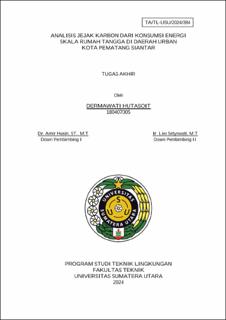Analisis Jejak Karbon dari Konsumsi Energi Skala Rumah Tangga di Daerah Urban Kota Pematang Siantar
Carbon Footprint from Energy Consumption Household Scale in the Urban Area of Pematang Siantar City

Date
2024Author
Hutasoit, Dermawati
Advisor(s)
Husin, Amir
Setyowati, Lies
Metadata
Show full item recordAbstract
Household activities are the third largest consumer of energy. Energy consumption in households, especially in urban areas (urban) comes from the use of LPG, fuel and electricity, where these activities have the potential to increase greenhouse gas emissions, leaving a carbon footprint that will affect environmental quality. This study aims to calculate the total carbon emissions from energy consumption in urban areas of Pematang Siantar City using the IPCC 2006 method, analyze the correlation between electric power, income and number of family members to the carbon footprint value, and map the distribution of carbon footprints with QGIS software. Primary data collection was conducted by interview and observation to respondents. The total carbon footprint obtained in the urban area of Pematang Siantar City is 89,731.49 tons of CO2eq/year, with details of LPG use of 12,236.53 tons of CO2eq/year, fuel use of 25,550.40 tons of CO2eq/year and electricity use of 51,944.56 tons of CO2eq/year. Among the three variables, the income variable has a significant, positive and strong relationship to the secondary carbon footprint and primary carbon footprint. The results of the spatial analysis of the total carbon footprint show that Bantan Village and Siopat Suhu Village are classified in the high range when compared to other villages so that they are marked with red spatial.
Collections
- Undergraduate Theses [404]
